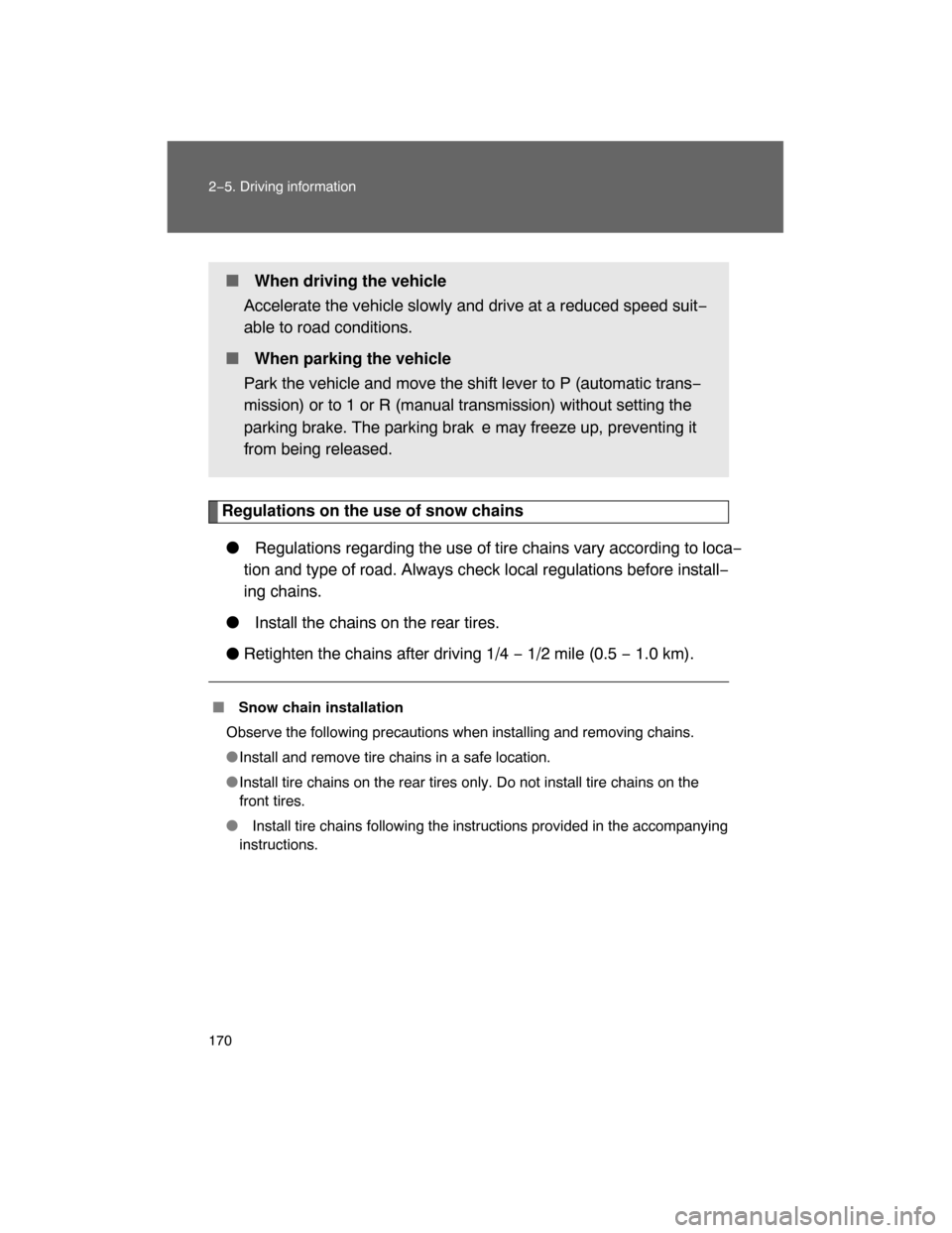Page 168 of 400

170 2−5. Driving information
Regulations on the use of snow chains
� Regulations regarding the use of tire chains vary according to loca−
tion and type of road. Always check local regulations before install−
ing chains.
� Install the chains on the rear tires.
�
Retighten the chains after driving 1/4 − 1/2 mile (0.5 − 1.0 km).
� Snow chain installation
Observe the following precautions when installing and removing chains.
�Install and remove tire chains in a safe location.
�Install tire chains on the rear tires only. Do not install tire chains on the
front tires.
� Install tire chains following the instructions provided in the accompanying
instructions.
� When driving the vehicle
Accelerate the vehicle slowly and drive at a reduced speed suit−
able to road conditions.
� When parking the vehicle
Park the vehicle and move the shift lever to P (automatic trans−
mission) or to 1 or R (manual transmission) without setting the
parking brake. The parking brak e may freeze up, preventing it
from being released.
Page 173 of 400

175
2−5. Driving information
2
When driving
� Before towing
Check that the following conditions are met:
�
Ensure that your vehicle’s tires are properly inflated. ( P. 370)
� Trailer tires should be inflated according to the trailer manufacturer ’s rec−
ommendation.
�All trailer lights work to be legal.
�Confirm all lights work each time you connect them.
�The trailer ball is set up at the proper height for the coupler on the trailer.
�Check that your vehicle remains level when a loaded or unloaded trailer
is hitched. Do not drive if the vehicle is not level, and check for improper
tongue load, overloading, worn suspension, or other possible causes.
� Make sure the trailer cargo is securely loaded.
�Check that your rear view mirrors conform to any federal, state/provincial
or local regulations. If they do not, in
stall rear view mirrors appropriate for
towing purposes.
�Break�in schedule
�Toyota recommends that you do not use a new vehicle or a vehicle with
any new power train components (engine, transmission, differential,
wheel bearings, etc.) to tow a trailer for the first 500 miles (800 km) of
driving.
� Maintenance
� If you tow a trailer, your vehicle will require more frequent maintenance
due to the additional load. (See “Scheduled Maintenance Guide” or
“Owner ’s Manual Supplement”.)
� Retighten the fixing bolts of the towing ball and bracket after approxi−
mately 600 miles (1000 km).
Page 176 of 400

178 2−5. Driving information
Trailer towing tips
Your vehicle will handle differently when towing a trailer. The three
main causes of vehicle−trailer ac cidents are driver error, excessive
speed and improper trailer loading. Keep these in mind when towing.
�
Before starting out, check the trailer ’s light and the vehicle−trailer
connections. Recheck after driving a short distance.
� Practice turning, stopping and reve rsing with the trailer attached in
an area away from traffic until you become accustomed to the feel
of the vehicle.
� Reversing with a trailer attached is
difficult and requires practice.
Grip the bottom of the steering wheel and move your hand to the
left to move the trailer to the left. Move your hand to the right to
move the trailer to the right. (This generally opposite to reversing
without a trailer attached.) Avoid sharp or prolonged turning. Have
someone guide you when reversing to reduce the risk of an acci−
dent.
� As stopping distance is increased when towing a trailer, vehicle−to−
vehicle distance should be increased. For each 10 mph (16 km/h)
of speed, allow at least o
ne vehicle and trailer length.
� Avoid sudden braking as you may skid, resulting in jackknifing and
loss of control. This is especially true on wet or slippery surfaces.
�
Avoid jerky starts or sudden acceleration. Vehicles with a manual
transmission, prevent excessive cl
utch slippage by keeping engine
rpm low and not racing the engine. Always start out in first gear.
�Avoid jerky steering and sharp turns, and slow down before mak−
ing a turn.
Page 177 of 400

179
2−5. Driving information
2
When driving
� Note that when making a turn, the trailer wheels will be closer than
the vehicle wheels to the inside of the turn. Compensate by making
a larger than normal turning radius.
� Crosswinds and rough roads will adversely affect handling of your
vehicle and trailer, causing sway . Periodically check the rear to
prepare for being passed by large trucks or buses, which may
cause your vehicle and trailer to sway. If swaying occurs, firmly grip
the steering wheel, reduce speed immediately but gradually, and
steer straight ahead. Never increase speed. If you make no
extreme correction with the stee ring or brakes, your vehicle and
trailer will stabilize.
�Take care when passing other vehicles. Passing requires consider−
able distance. After passing a vehicle, do not forget the length of
your trailer, and be sure you hav
e plenty of room before changing
lanes.
�
In order to maintain engine braking efficiency, do not use the trans−
mission in D (automatic transmiss
ion) or 6 (manual transmission).
� Due to the added load of the trailer, your vehicle’s engine may
overheat on hot days (at temperatures over 85°F [30°C]) when
driving up a long or steep grade. If the engine coolant temperature
gauge indicates overheating, immedi
ately turn off the air condition−
ing (if in use), pull your vehicle off the road and stop in a safe spot.
(
P. 356)
Page 178 of 400

180 2−5. Driving information
� Always place wheel blocks under both the vehicle and the trailer
wheels when parking. Apply the parking brake firmly, and put the
transmission in P (automatic transmission) or in 1 or R (manual
transmission). Avoid parking on a slope, but if unavoidable, do so
only after performing the following:
Apply the brakes and keep them applied.
Have someone place wheel bloc
ks under both the vehicle and
trailer wheels.
When the wheel blocks are in place, release the brakes slowly
until the blocks absorb the load.
Apply the parking brake firmly.
Shift into 1 or R (manual transmission) or P (automatic trans−
mission) and turn off the engine.
� When restarting after parking on a slope:
With the transmission in P (automatic transmission) or the
clutch pedal (manual transmission) depressed, start the
engine. On vehicles with an au tomatic transmission, be sure
to keep the brake pedal pressed.
Shift into a forward gear. If reversing, shift into R.
Release the parking brake (also
brake pedal on vehicles with
an automatic transmission), and slowly pull or back away from
the wheel blocks. Stop and apply the brakes.
Have someone retrieve the blocks.
Page 226 of 400
229
3−4. Using the storage features
3
Interior features
Cup holders (front)
Vehicles with an automatic transmission
CAUTION
� Caution while driving
Keep the glove box closed.
Injuries may result in the event of an accident or sudden braking.
Glove box and Cup holders (front)
Page 227 of 400
230 3−4. Using the storage features
Vehicles with a manual transmission
� Holding large cups
Vehicles with an automatic transmission
Remove the adapter.
Cup holders (front)
Page 228 of 400
231
3−4. Using the storage features
3
Interior features
Vehicles with a manual transmission
CAUTION
� Items unsuitable for the cup holder
Do not place anything other than cups or aluminum cans in the cup holders.
Other items may be thrown out of the holders in the event of an accident or
sudden braking and cause injury. If possible, cover hot drinks to prevent
burns.
Remove the adapter.
Cup holders (front)